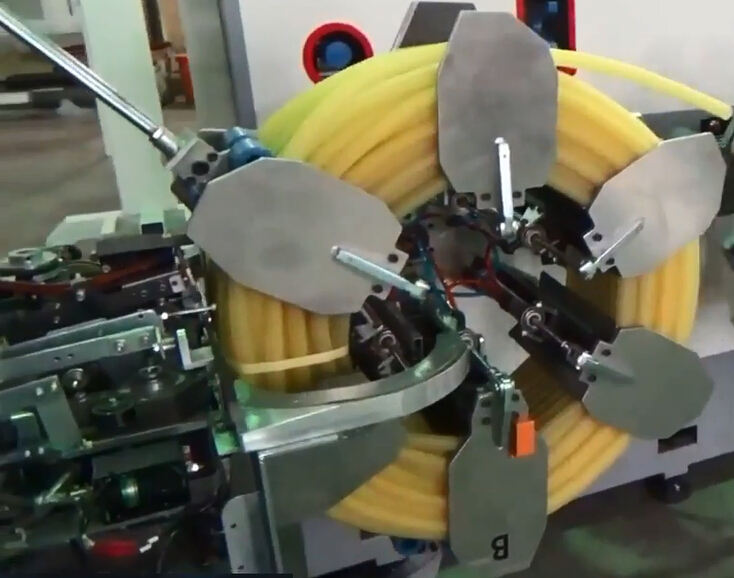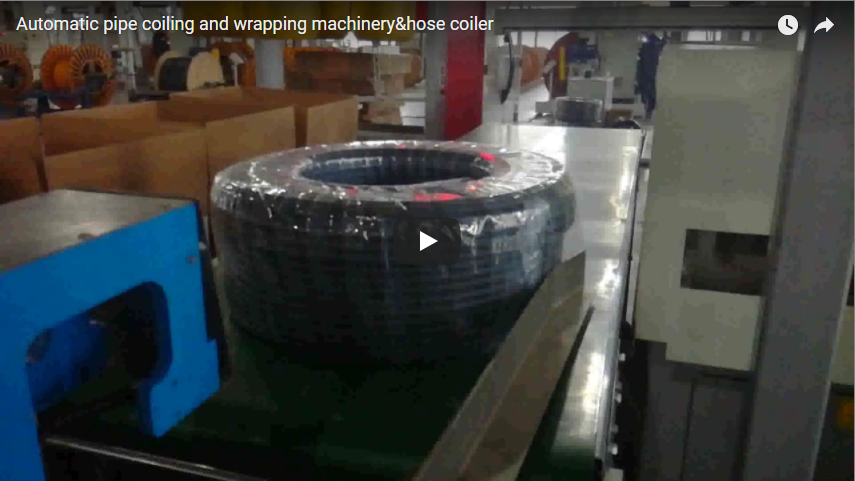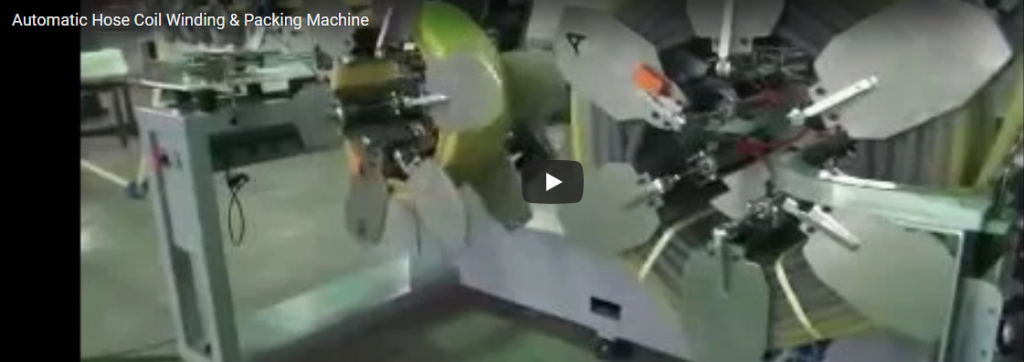Efficiently managing and packaging hoses—from garden varieties to robust industrial conduits—presents unique challenges. Manual coiling is often labor-intensive, inconsistent, and slow, impacting productivity and potentially damaging the product. The Automatic Coiler for Hose offers a sophisticated, automated solution, specifically engineered to streamline the winding and coiling process for hoses, industrial tubing, and other flexible pipes. This advanced hose winding machine ensures the creation of tight, uniform coils rapidly and reliably, safeguarding hose integrity while boosting operational throughput.
1. Advanced Design and Robust Structure
Built for demanding industrial environments, the automatic hose coiler features a robust frame designed for stability and longevity. Key structural components often utilize materials like high-grade steel or stainless steel (as noted in the specifications below) to ensure corrosion resistance and durability, particularly important when handling various hose materials or operating in potentially humid conditions. The overall design prioritizes ease of access for maintenance and integration into existing production lines.
2. Core Components and Precision Functionality
The machine's effectiveness stems from the synergy of its primary components:

2.1 Adjustable Coiling Head
This critical component is engineered for versatility. It can typically be adjusted to accommodate a wide range of hose diameters and desired final coil dimensions (both inner and outer diameter). This adaptability ensures uniformly wound coils, regardless of the specific hose type, which is crucial for standardized packaging and stable palletizing.
2.2 Precision Feed Mechanism
A smooth, consistent feed is vital to prevent hose damage (like kinking or stretching) during the coiling process. The feed mechanism, often employing driven rollers or belts, carefully guides the hose towards the coiling head at a synchronized speed, maintaining appropriate tension.
2.3 Automated Cutting System
Integrated cutting, often a pneumatic or servo-driven blade, ensures precise hose lengths for each coil. This automated step significantly speeds up the production cycle by eliminating manual cutting, reducing waste, and ensuring consistent product length.
2.4 PLC Control System with Touchscreen Interface
Modern automatic hose coilers are typically governed by a Programmable Logic Controller (PLC). This provides:
- User-Friendly Operation: An intuitive touchscreen interface (HMI) allows operators to easily set parameters like coil length, diameter, coiling speed, and tension.
- Recipe Storage: Pre-set configurations for different hose types can be stored and recalled, minimizing setup time between production runs.
- Diagnostics: Real-time monitoring and diagnostic feedback help troubleshoot issues quickly, maximizing uptime.
- Integration: PLCs facilitate communication with upstream (e.g., extruders) and downstream (e.g., strapping or wrapping machines) equipment for fully automated lines.
3. Technical Specifications Overview
Understanding the machine's capabilities is key. Below are typical parameters for a model like the one discussed.

Disclaimer: The parameters listed below provide a general specification guideline and may not perfectly match the equipment shown in the video. For exact machine specifications tailored to your application, please contact us directly.
- Machine Type: Automatic Hose Coiler
- Example Model: HC-200Pro
- Typical Year of Manufacture: 2023 onwards
- Hose Diameter Compatibility: 10mm – 100mm (Adjustable range varies by model)
- Maximum Coil Outer Diameter: Up to 800mm (Application dependent)
- Coiling Speed: Up to 50 meters per minute (Variable based on hose type and coil size)
- Control System: PLC with HMI Touchscreen Operation
- Power Requirements: Typically 380V, 50Hz, Three Phase (configurable)
- Approx. Machine Dimensions: Length: 3000mm; Width: 1500mm; Height: 2000mm (Varies by configuration)
- Primary Structural Material: Stainless Steel options available for enhanced corrosion resistance
- Coil Binding/Securing Options: Compatible with downstream systems for Nylon ties, strapping, stretch wrapping, or heat sealing
- Adjustable Tension Control: Yes, critical for coil tightness and hose protection
- Safety Features: Integrated safety guarding, light curtains, emergency stop buttons compliant with safety standards
- Compliance Standards: Often designed to meet CE, ISO 9001
- Maintenance Features: Designed with accessible panels for routine checks and maintenance
- Operator Training: Typically provided during installation and commissioning
- Warranty: Standard manufacturer warranty (e.g., 1-5 years, may vary)
4. Operational Advantages and User Experience
Implementing an automatic hose coiler delivers tangible benefits:
4.1 Enhanced Productivity and Throughput
With coiling speeds significantly faster than manual methods (e.g., up to 50 m/min), these machines drastically increase production output, allowing manufacturers to meet higher demand and reduce lead times.
4.2 Consistent and High-Quality Coils
Automation eliminates human variability, resulting in consistently tight, neat, and dimensionally accurate coils. This improves stackability, simplifies packaging, reduces storage space requirements, and enhances the end-product's appearance and handling.
4.3 Labor Savings and Improved ROI
By automating the coiling and cutting process, manufacturers can reallocate labor to more value-added tasks. The reduction in manual labor, coupled with increased throughput and reduced material waste, leads to a compelling Return on Investment (ROI). The intuitive PLC controls also minimize the operator learning curve.
4.4 Enhanced Safety and Ergonomics
Automated systems reduce the need for repetitive manual handling and cutting tasks, lowering the risk of ergonomic injuries. Integrated safety features protect operators during machine operation.
5. Key Applications Across Hose Manufacturing Sectors
The versatility of the automatic coiler makes it suitable for various industries:
5.1 High-Volume Garden Hose Production
Achieves rapid, uniform coiling necessary for retail packaging appeal and efficient distribution. Handles standard PVC and reinforced garden hoses effectively.
5.2 Industrial Hose Coiling Solutions
Manages larger diameter, heavier, or more rigid hoses used in industrial applications (e.g., air, water, hydraulic). Ensures secure coiling for transport and storage in demanding environments.
5.3 Precision Coiling for Flexible Pipes and Tubing
Provides gentle handling and precise coiling essential for flexible pipes used in irrigation, automotive fuel lines, medical tubing, or pneumatic systems, where maintaining integrity and avoiding kinks is paramount.
6. Conclusion: Optimizing Hose Packaging Operations
The Automatic Coiler for Hose represents a significant technological advancement for manufacturers dealing with hoses and flexible pipes. By combining robust design, precision components, intelligent PLC control, and automated processes, this equipment addresses key challenges related to efficiency, consistency, cost, and quality. Its adoption can lead to substantial improvements in productivity and a stronger competitive position in the market. Adherence to standards like ISO 9001 further underscores a commitment to quality management in manufacturing processes utilizing such equipment.
For more detailed information on how an automatic hose coiler can be configured for your specific application, please contact us at info@fhopepack.com.






